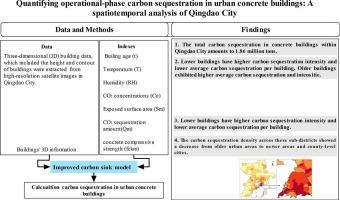Quantifying operational-phase carbon sequestration in urban concrete buildings: A spatiotemporal analysis of Qingdao City
IF 7.1
2区 工程技术
Q1 CONSTRUCTION & BUILDING TECHNOLOGY
引用次数: 0
Abstract
Concrete structures in urban buildings act as carbon sinks, continually capturing and storing carbon dioxide. Accurate calculation of CO2 uptake in urban concrete buildings and understanding the spatial distribution of carbon sequestration across a city are crucial. In this study, we calculated the carbon sequestration capacity of concrete buildings using an optimized Fick’s law and examined the spatiotemporal characteristics of carbon sequestration in Qingdao City, China. The results indicated that urban concrete buildings in Qingdao sequesters approximately 1.86 million tons of carbon. Carbon sequestration varies significantly by building type, with residential buildings showing the highest ratio of total carbon sequestration and carbon sequestration intensity. Lower buildings generally had a higher proportion and intensity of carbon sequestration. Additionally, carbon sequestration displayed time-dependent characteristics, as older buildings tended to show higher average carbon sequestration and intensity. The spatial distribution of carbon sequestration across Qingdao is uneven, with carbon sequestration decreasing from older to newer urban areas and county-level cities, from district centers to their peripheries, and from the city center to the suburb regions. These findings are critical for evaluating the role of urban concrete buildings as carbon sequestration on an urban scale and provide valuable insights for urban planning and development.

青岛市城市混凝土建筑运行期固碳量的时空分析
城市建筑中的混凝土结构充当碳汇,不断捕获和储存二氧化碳。准确计算城市混凝土建筑的二氧化碳吸收量和了解整个城市碳封存的空间分布至关重要。本研究利用优化后的菲克定律计算了青岛市混凝土建筑的固碳能力,并考察了青岛市混凝土建筑固碳的时空特征。结果表明:青岛市城市混凝土建筑固碳量约186万吨;不同建筑类型固碳量差异显著,其中住宅建筑固碳总量与固碳强度比值最高。低层建筑的固碳比例和强度普遍较高。此外,碳固存表现出时间依赖特征,老建筑的平均碳固存和强度往往更高。青岛市城市碳汇空间分布不均衡,碳汇由老城区和县级市向新城区和新城区递减,由中心区向外围递减,由市中心向郊区递减。这些发现对于评估城市混凝土建筑在城市尺度上的碳封存作用至关重要,并为城市规划和发展提供了有价值的见解。
本文章由计算机程序翻译,如有差异,请以英文原文为准。
求助全文
约1分钟内获得全文
求助全文
来源期刊

Energy and Buildings
工程技术-工程:土木
CiteScore
12.70
自引率
11.90%
发文量
863
审稿时长
38 days
期刊介绍:
An international journal devoted to investigations of energy use and efficiency in buildings
Energy and Buildings is an international journal publishing articles with explicit links to energy use in buildings. The aim is to present new research results, and new proven practice aimed at reducing the energy needs of a building and improving indoor environment quality.
 求助内容:
求助内容: 应助结果提醒方式:
应助结果提醒方式:


